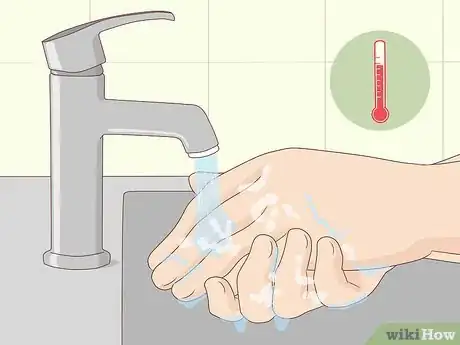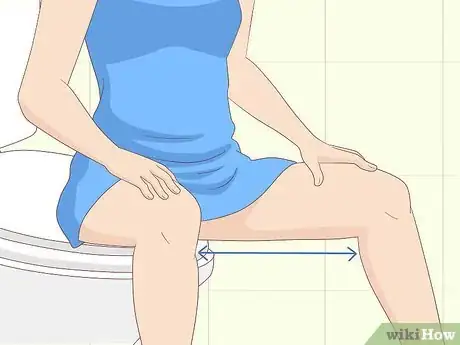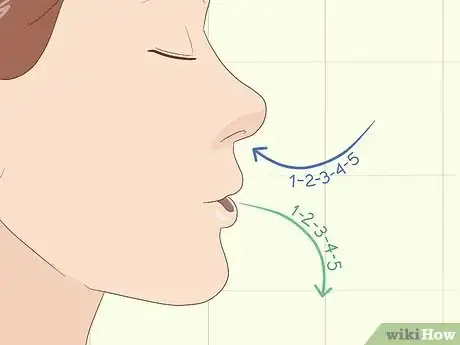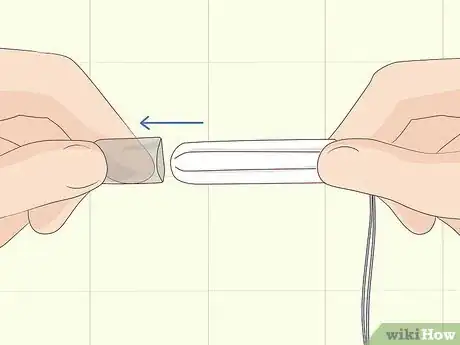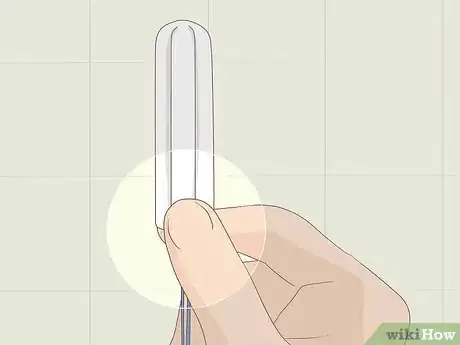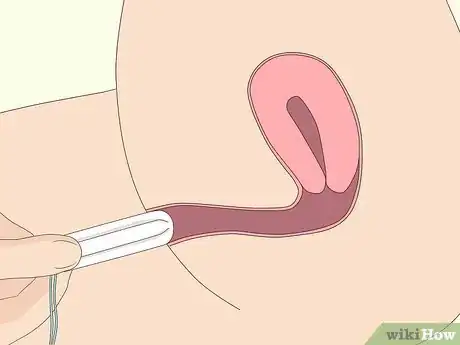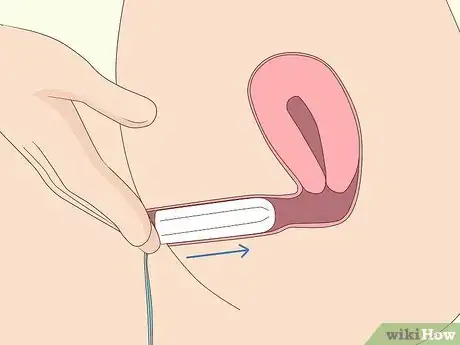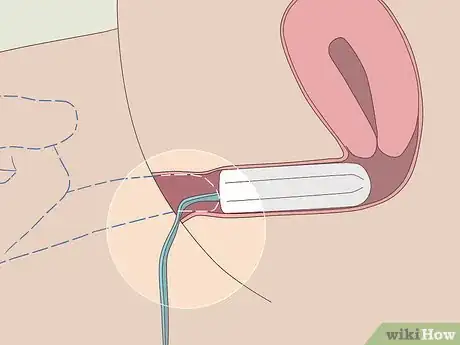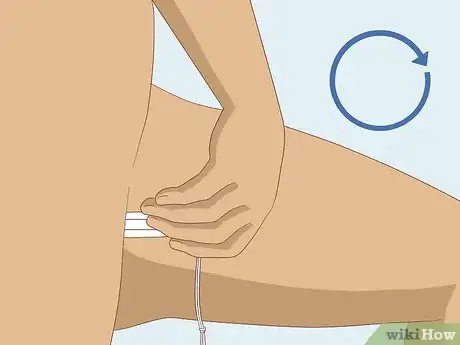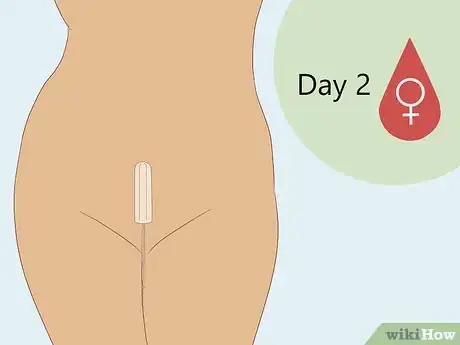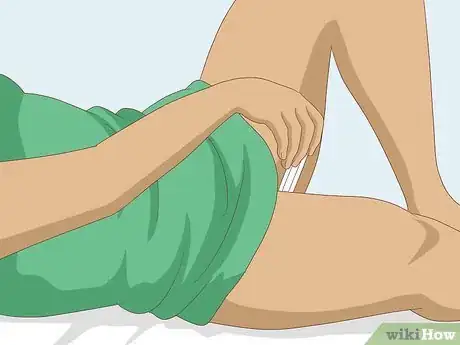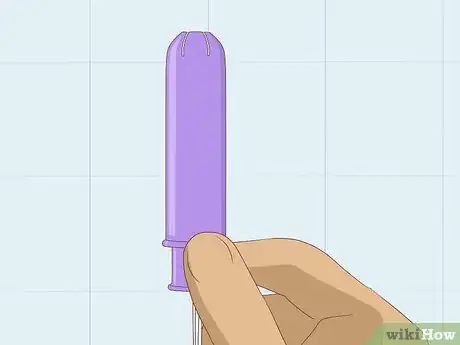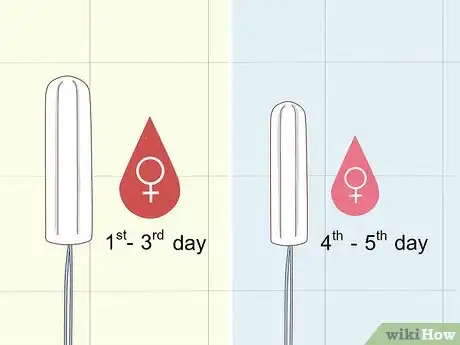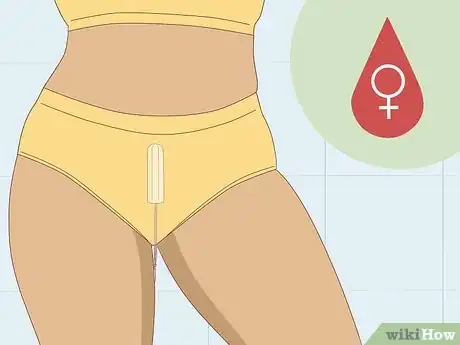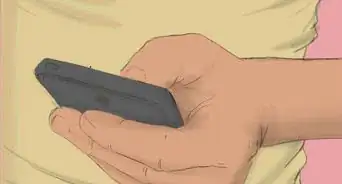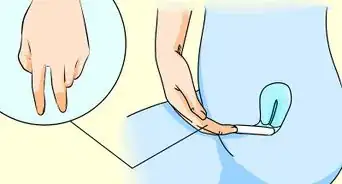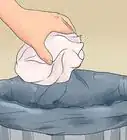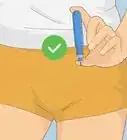This article was co-authored by Rebecca Levy-Gantt, MPT, DO and by wikiHow staff writer, Danielle Blinka, MA, MPA. Dr. Rebecca Levy-Gantt is a board certified Obstetrician and Gynecologist running a private practice based in Napa, California. Dr. Levy-Gantt specializes in menopause, peri-menopause and hormonal management, including bio-Identical and compounded hormone treatments and alternative treatments. She is also a Nationally Certified Menopause Practitioner and is on the national listing of physicians who specialize in menopausal management. She received a Masters of Physical Therapy from Boston University and a Doctor of Osteopathic Medicine (DO) from the New York College of Osteopathic Medicine.
wikiHow marks an article as reader-approved once it receives enough positive feedback. In this case, several readers have written to tell us that this article was helpful to them, earning it our reader-approved status.
This article has been viewed 314,683 times.
Tampons are an easy, discreet option for managing your periods. However, you might hate the waste the applicators create. Fortunately, you can insert a tampon without an applicator! Simply wash your hands and get into a position that opens your vagina. Then, use your middle finger to push the tampon up into your vagina. If you experience pain, there are some changes you can make to reduce it.
Steps
Getting into Position
-
1Wash your hands with soap and warm water. Wet your hands with warm water, then apply a mild soap to your palm. Scrub your hands with soap for at least 30 seconds. Finally, rinse your hands with warm water.[1]
- Don’t insert a tampon with dirty hands because the germs will get on your tampon. This could cause an infection.
-
2Sit on your toilet with your knees spread apart to open your vagina. Get comfortable on the toilet, then widen your legs so it’s easy to access your vagina. This makes it easier to slide the tampon inside your vagina.[2]
- If another position works better for you, do that instead. What matters is that you’re comfortable and able to access your vagina.
Variation: As another option, stand up and put 1 leg up on the toilet. This will help you spread your legs and put your body at an angle that may make it easier to insert the tampon.
-
3Take deep breaths to relax yourself so it’s easier to insert it. If your muscles are tight, it’ll be harder to push the tampon inside your vagina. To help you relax, take slow, deep breaths. Try counting to 5 as you inhale, then counting to 5 as you exhale. Repeat 5 times.[3]
- It’s normal to feel nervous when you’re just starting to use tampons. Just do your best to relax your body.
-
4Unwrap the tampon and extend the string. Tear the top of the wrapper and remove the tampon. Hold the tampon carefully at the base to minimize how much contact your fingers have with the tampon. Throw away or recycle the wrapper.[4]
- While your hands are clean, it’s still possible to transfer germs or bacteria to the tampon. Do your best to touch the tampon as little as possible.
- If your tampons don’t come with a wrapper, lift the tampon out of the box by grasping at the base.
Pushing the Tampon into Your Vagina
-
1Hold the base of the tampon between your thumb and index finger. Grasp the tampon as close to the base as possible. Use your thumb and index finger to grip it easily. Hold it securely so that you won’t accidentally drop it into the toilet.[5]
Variation: You might prefer to create an indentation at the base of the tampon so that you can put it in using just your middle finger. Press your middle finger into the base slightly so you can insert it.
-
2Open your vagina with the tip of the tampon or your other hand. The folds of your vagina should open easily when you push the tampon into them. If you’re having trouble, use the thumb and index finger on your free hand to gently push them open.[6]
- If this is your first time using a tampon, it might help to use a hand mirror to examine your vagina before you try to insert the tampon.
-
3Push the tampon up into your vagina. Use your fingers to insert the tip of the tampon into your vagina. Push it in as far as you can with the fingers you’re using. As you do this, make sure the string is dangling out of your vagina.[7]
- You likely won’t be able to get it all the way up on your first push, and that’s okay!
-
4Use your middle finger to push the tampon as far as it comfortably goes. Place your middle finger at the center of the base, then push it as far up into your vagina as your hand allows. Stop pushing when you reach the base of your finger. This should put the tampon in the right place.[8]
- If your ring finger is longer than your middle finger, use that one instead.
-
5Leave the string hanging out of your vagina. You need the string to pull out the tampon, so make sure it’s hanging out of your vagina before you remove your finger. Don’t pull on the string until you’re ready to remove the tampon.[9]
- If you pull on the string when you remove your finger, your tampon may get dislodged. If this happens, you can try pushing it back into place with your finger. However, you may need to change your tampon.
-
6Remove your finger from your vagina and wash your hands. Slowly pull your finger out of your vagina, being careful not to pull on the string. Then, wipe off any menstrual fluids using a piece of toilet paper. Discard the toilet paper in the toilet or the trash. Finally, wash your hands with soap and water to clean your finger.[10]
- If your finger smells, wash your hands twice using soap.
-
7Check that your tampon feels comfortable. Your tampon shouldn’t feel uncomfortable, but sometimes that can happen when it’s in the wrong spot. To make sure it’s comfortable, march slowly in place or shake your hips.[11]
- If it feels uncomfortable, try pushing it further up into your vagina using your middle finger. If this doesn’t work, you may need to remove it and insert a new tampon.
Minimizing Pain from Tampons
-
1Practice putting in a tampon so that it gets easier. Tampons might feel painful if you’re putting them in wrong. The best way to get over this is to practice putting them in. You should start to feel more comfortable if you use them regularly.[12]
- Try to use them consistently for an entire period. This will help you get good at inserting them.
- It’ll be harder to get better if you’re only using tampons occasionally, like when you go swimming or play sports.
-
2Use the tampon for the first time when you’re on your heaviest day. Tampons go in more easily if your vagina is moist. That means they might be scratchy on your light flow days. If tampons are new for you, wait until your heaviest period day to try to insert one.[13]
- Typically, day 2 will be your heaviest day. However, your flow may also be heavy on day 1 or 3.
-
3Lie down so it’s easier to relax while you put in your tampon. If your muscles are tense, it’ll be hard to insert the tampon. It may be hard for you to relax on the toilet or standing up, so try lying down. Get into a comfortable position, take some deep breaths, and then try to insert the tampon.[14]
- You likely won’t need to do this every time. However, lying down may help you get used to inserting tampons if you’re new to it.
-
4Try using an applicator if you’ve just started using tampons. You probably have your reasons for wanting to ditch the applicator, like creating less trash. However, applicators make tampons much easier to insert. You can get either a cardboard or a plastic applicator. Use applicators until you get used to tampons.[15]
- Plastic applicators are usually more comfortable to insert. However, they can be more costly and have a higher environmental impact.
- Cardboard applicators are usually easy to insert, but they might cause more friction than plastic applicators.
-
5Make sure you have the right tampon absorbency for your flow. Tampons come in different sizes to accommodate your flow on different days of your period. For instance, you don’t need the same size tampon on a light day as on a heavy day. If you’re using a tampon that’s too big, it’ll create more friction and stay dry, so it’ll cause you more pain. Pick the right absorbency for you.[16]
- Use light tampons on the first and last few days of your period when your flow is lighter.
- Pick regular or normal absorbency for your heavy flow days.
- Use a super absorbency on your heaviest day or for a very heavy flow.
- Try a super plus tampon only if you have abnormally heavy periods.
-
6Use tampons only when you’re on your period. You might feel tempted to practice inserting tampons when you’re not on your period. However, your vagina will be dry, so the tampons will hurt during insertion and when you pull them out. Only wear tampons when you actually have your period.[17]
- If you think you’re about to start your period, use a pantyliner to protect your underwear. Don’t use a tampon until your period starts.
Warnings
- Change your tampons every 4 to 6 hours to stay safe. Don’t leave your tampon in longer than 8 hours because it increases your risk of Toxic Shock Syndrome (TSS).[19]⧼thumbs_response⧽
References
- ↑ https://www.menstrupedia.com/articles/girls/how-tampon
- ↑ https://obgyn.coloradowomenshealth.com/health-info/teens/how-to-insert-tampon
- ↑ https://obgyn.coloradowomenshealth.com/health-info/teens/how-to-insert-tampon
- ↑ https://obgyn.coloradowomenshealth.com/health-info/teens/how-to-insert-tampon
- ↑ https://www.menstrupedia.com/articles/girls/how-tampon
- ↑ https://obgyn.coloradowomenshealth.com/health-info/teens/how-to-insert-tampon
- ↑ https://www.menstrupedia.com/articles/girls/how-tampon
- ↑ https://www.menstrupedia.com/articles/girls/how-tampon
- ↑ https://obgyn.coloradowomenshealth.com/health-info/teens/how-to-insert-tampon
- ↑ https://www.menstrupedia.com/articles/girls/how-tampon
- ↑ https://obgyn.coloradowomenshealth.com/health-info/teens/how-to-insert-tampon
- ↑ https://kidshealth.org/en/teens/use-tampon.html
- ↑ https://kidshealth.org/en/teens/use-tampon.html
- ↑ https://www.plannedparenthood.org/learn/teens/ask-experts/how-do-i-put-a-tampon-in
- ↑ https://kidshealth.org/en/teens/use-tampon.html
- ↑ https://obgyn.coloradowomenshealth.com/health-info/teens/how-to-insert-tampon
- ↑ https://youngwomenshealth.org/2014/07/02/is-it-bad-to-insert-a-tampon-before-going-swimming-if-im-not-on-my-period-yet-im-afraid-ill-start-in-the-water/
- ↑ https://www.fda.gov/consumers/consumer-updates/facts-tampons-and-how-use-them-safely
- ↑ https://obgyn.coloradowomenshealth.com/health-info/teens/how-to-insert-tampon
